What Diwali Means to Me
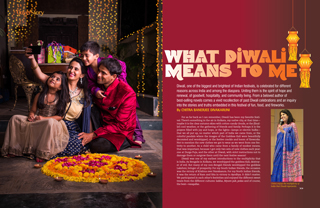
Diwali, one of the biggest and brightest of Indian festivals, is celebrated for different reasons across India and among the diaspora. Uniting them is the spirit of hope and renewal, of goodwill, hospitality, and community living. From a beloved author of best-selling novels comes a vivid recollection of past Diwali celebrations and an inquiry into the stories and truths embedded in this festival of fun, food, and fireworks.
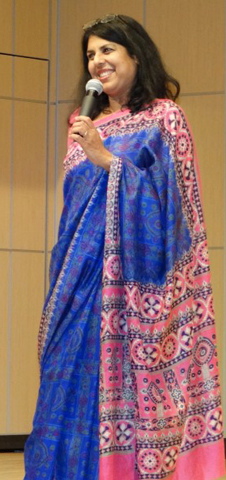
(Right) Chitra enjoys the multiplicity of India that Diwali represents.
For as far back as I can remember, Diwali has been my favorite festival. There’s something in the air in Kolkata, my native city, at that time—maybe it is the clear autumn skies with cotton-candy clouds, or the (finally!) cool weather, or the gathering of friends and family. Perhaps it is the prayers filled with joy and hope, or the lights—lamps or electric bulbs—that we all put up, no matter which part of India we came from, or the colorful pandals where the images of the Goddess Kali were beautifully decorated and worshiped, or the festive crackle and boom of fireworks. Not to mention the new clothes we got to wear as we went from one festivity to another. As a child who came from a family of modest means, that was important, because I got only two sets of new clothes each year: one at Durga Puja, and the other at Diwali, with strict instructions not to damage them or outgrow them until the next festive season!
Diwali was one of my earliest introductions to the multiplicity that is India. As Bengalis in Kolkata, we worshiped the goddess Kali, destroyer of evil. But many of my non-Bengali friends worshiped the goddess Lakshmi, bringer of prosperity. For my South Indian friends, the occasion was the victory of Krishna over Narakasura. For my North Indian friends, it was the return of Ram and Sita in victory to Ayodhya. It didn’t matter. We participated in each other’s festivities and enjoyed the different sweet treats from the different cultures: laddus, Mysore pak, pedas and of course, the best—rasagullas.
So it was natural that when I arrived in the United States as a graduate student in the 1970s, I missed Diwali deeply. That was the time when I was the most homesick. I was living in the Midwest at that time, on a campus where there were very few Indian students. The trees would start losing their leaves and the days would start getting shorter right around Diwali. I wasn’t used to the change of seasons; it depressed me. It felt as though life was coming to an end. As I stared at the bare branches of the trees behind my dingy student apartment, I realized how much, along with the many gains, the immigrant loses: family and friends, but more than that, an entire community to celebrate with. Those first few Diwalis in America, I observed the festival alone, with many tears, lighting my lamp on my makeshift altar, attempting to make rasagullas that turned out hard as rocks.
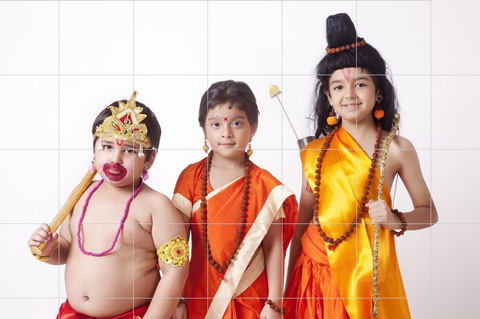
(Right) Children dressed up for a Diwali cultural program.
Fortunately, when I moved to the West Coast for my Ph.D. studies, I was able to find a community of Indians. In those early days, there weren’t that many of us. Most of us had limited finances, so we couldn’t celebrate in a grand way. But the advantage of this was that we all celebrated together, weaving the many strands of our customs into a beautiful design. Often, we rented a small hall, either on a college campus or in a school, and got together for an evening of prayer, followed by a potluck feast. The first year, as the resident Bengali, I was assigned to make rasagullas. They were, to put it mildly, not a success, and from the next year, I was demoted to cooking rice!
The evening usually ended with a homespun entertainment program consisting of songs, dances, and plays, usually performed with more enthusiasm than talent! It didn’t matter. We all had a great time and appreciated the fact that we were able to keep in touch with our culture halfway across the world.
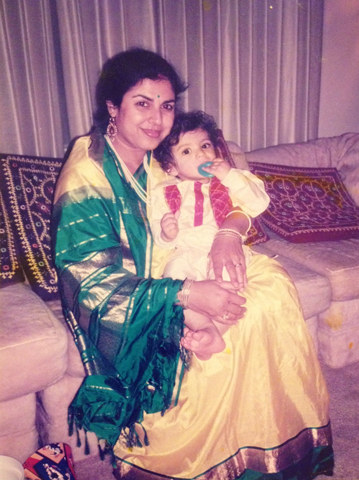
(Left) Chitra with her younger son, Abhay, in younger days.
After I got married and had children, the meaning of Diwali changed its nature somewhat for me. Now I felt a great urge to pass on my culture, and its deep meanings, to the next generation. I told my children all the stories about Diwali that I could find (thank you, Amar Chitra Katha!). I encouraged them, along with their friends, to enact the stories of Ram and Sita returning in triumph to their kingdom. Hanuman was by far the favorite character in this story. All the children—boys and girls—wanted to be him and wear tails made out of my twisted dupattas (traditional Indian two-meter scarves). The battle of Krishna and Narakasura was another popular “play” that we put on, with much dueling with lightsabers, which were popular at the time.
We’d hold small gatherings at different homes for Diwali, because the children got bored at the long drawn out community adult celebrations and pujas, and we really wanted them to feel that our Indian festivals were fun. We involved our children in the making of traditional sweets. Both my sons learned to make good quality sandesh at that time, though, alas, our rasagullas still turned out like rocks.
 Sparkler crop 420.jpg)
The highlight of the evening would be the fireworks (mostly sparklers) that the parents bought during the Fourth of July and hoarded carefully. We would get together in one of our friends’ backyards to surreptitiously burn them, keeping an eye out for the police because it was a not-quite-legal activity. I think the children got a big kick out of that, because when recently, I asked some of them—now grown—what they remembered about those early Diwali celebrations, they all said, “Fireworks!”
Now that a couple of decades have passed, I see Diwali and the way it is celebrated changing across the United States. I live in Houston, which is blessed with one of the largest Indian-American populations, and Diwali is celebrated in a big way here, so I am very aware of these changes (possibly changes are happening in Diwali celebrations in India as well, though in their own ways).
 Fireworks BAPS 680.jpg)
I am not a particularly nostalgic person, so I do not think of change as necessarily negative, as long as we are conscious of the things we are changing, and have a good reason as to why we want to change them. But one of the things that bother me about how we celebrate Diwali in large cities in the U.S. is that each community now celebrates separately.
We have several temples in Houston. The Meenakshi Temple, the Ashta Lakshmi Temple, the Iskcon Temple, the Swaminarayan Temple, the Krishna Vrundavana Temple, and the Houston Durgabari are just a few of these. Each one is supported primarily by one (often language and state-based) community and performs Diwali in their own way. There is a subterranean assumption that theirs is the right way, or at least the best way, to celebrate Diwali. Our larger numbers have now divided us, so that instead of identifying ourselves as Indian, we often think that we are primarily Bengalis, Gujaratis, Tamilians, etc. People might say that this is what happens in India, too. But our situation in the United States is different. As an immigrant community, I feel it is very important for us to come together and be a unified whole. In our wholeness as Indian-Americans lies our strength, particularly in these times.
Fortunately, we do have one thing to bring us together—shopping! A huge Diwali Mela is held each year in Houston, where people come (sometimes even from neighboring cities) to sample delicacies of many kinds, stock up on Indian clothing and jewelry, and watch fireworks displays (now sanctioned by the city, which shows what a long way we’ve come). Also, everyone is happy to listen to songs from that other pan-Indian institution—Bollywood! The Mela is also a great venue to take our non-Indian friends to, to introduce them to our culture—and I feel that is also important for us as an immigrant community.
For myself, as I grow older, the spiritual aspect of Diwali becomes more and more crucial. Especially when I was writing my newest novel, The Forest of Enchantments, which is the tale of Sita narrated by herself, in her own voice with her thoughts and questions, I thought a lot about Diwali—the way it must have been celebrated when Sita returns with Ram to Ayodhya.
The victory of light over darkness—what did it really mean then, and what does it mean in my life as a woman living in the 21st century?
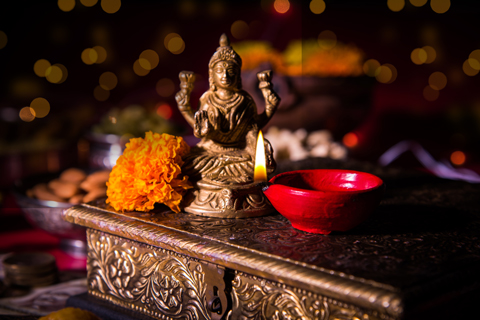
“The lights of Diwali, for me, symbolized resistance, faith, and courage amid darkness and danger…”
In my imagination, I saw that first Diwali as a woman-centric festival, the women of the city gathering around Sita in the lamplit evening, full of curiosity and questions. They would understand the trials of her captivity in Lanka far better than any man would. They would sympathize and admire her strength, which forced Ravan to respect her even though she was his prisoner. The lights of Diwali, for me, symbolized resistance, faith, and courage amid darkness and danger—the flame that burned in Sita in her blackest, bleakest times—the flame that burns in every woman and empowers us to fight against injustice. All we have to know is how to turn inward and get in touch with it.
So now I try to celebrate my Diwali with a balance of public celebration and private introspection. I make it a point to dress up in a festive sari (I love and treasure my saris; over the years, I have collected several from different regions of India, and there never seem to be enough occasions to wear them). I go to the temple and take in the lovely atmosphere: the fragrance of incense and flowers, the chanting of timeless prayers in Sanskrit, the rituals, the arati in which we all participate, and of course the prasad! Sometimes I go garba dancing as well, though I am at best an amateur, and sometimes—full confession—during the dandiya dance, I hit my dance partners’ knuckles instead of neatly connecting with their sticks.
But I try to find some time, usually in the evening when the household has quieted down, to go to my puja altar and light a lamp and think about what all this really signifies. I focus on the Light that my little lamp symbolizes, the Light that is in my heart, and I pray that it might shine brighter. That it might burn away my faults and errors and dark failings. That I might dissolve into it and become its joyful instrument. That every word I write might be inspired by it.
Ultimately, that is what Diwali means to me.
Chitra Banerjee Divakaruni is an award-winning and best-selling author, poet, activist, and teacher. Her books have been translated into 29 languages, including Dutch, Hebrew, Bengali, Russian, and Japanese, and many of them have been used for campus-wide and city-wide reads. Several of her works have been made into films and plays. She teaches creative writing at the University of Houston and is on the advisory board of Daya, an organization helping survivors of domestic abuse. Her latest novel is called The Forest of Enchantments. A review and an excerpt follow.
Sita’s Story
Chitra Banerjee Divakaruni’s new book, The Forest of Enchantments, published by HarperCollins India, is a brilliant retelling of the Ramayana from the perspective of its heroine, Sita.
Reviewed by Poornima Apte
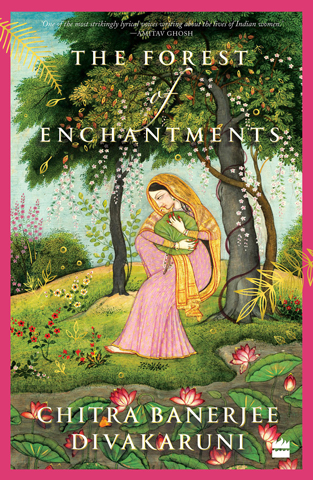
When I was attending college in Varanasi, I remember the entire city being paralyzed every Sunday afternoon because of the screening of the televised version of the Hindu epic, Ramayana. The popular retelling had an impressive hold on the collective imagination. After all, the gripping story, filled with gods and rakshasas (powerful beings with demonic powers in Hindu mythology), packs more punch than a Bollywood movie ever could.
Ramanand Sagar might have pulled off his interpretation of the Ramayana successfully, but taking on the retelling of a sacred Hindu epic is like playing with fire. You have to know what you’re doing as your version must hold up to scrutiny by dozens of experts, self-professed or otherwise. But Chitra Banerjee Divakaruni, research solidly in place, goes where not many have ventured before—and succeeds brilliantly.
In an expert twist, Divakaruni’s The Forest of Enchantments turns the classic tale on its head, delivering the epic from the woman’s point of view. When Valmiki, the chronicler of the magnum opus, presents the Ramayana to Sita, she expresses her concern: “You haven’t understood a woman’s life, the heartbreak at the core of her joys, her unexpected alliances and desires, her negotiations where, in the hope of keeping one treasure safe, she must give up another.” So, Valmiki passes the baton on to Sita. This telling, in other words, is aptly called the Sitayana.
Growing up in India, I had always thought of Sita as the submissive one, the wronged one, whose only succor at her darkest hour is Mother Earth who takes her into her arms. Divakaruni used to have the same image of Sita: “good and meek and long-suffering, bearing her misfortunes with silent stoicism.” But the true storyteller that she is, Divakaruni dives into the other side of the popular Hindu epic: Was Sita really as submissive as she is portrayed to be? What battles did she have to fight? Which ones did she choose to tackle?
It is quite an impressive feat to compress this vast epic into a readable and engaging novel and Divakaruni pulls it off with ease. Readers familiar with the narrative will delight to see the entire cast of characters paraded out here: King Dasharatha, Queen Kaushalya, Queen Kaikeyi in Ayodhya; Sita’s sister, Urmila; Ravana, Surpanakha, Lakshmana, Shatru-ghna. Reading this delightful novel is like a reunion with old friends. All the pivotal scenes are here too: Rama’s stringing of the bow; the banishment for 14 years; Sita’s abduction by Ravana; the great showdown in Lanka.
Above all, Divakaruni’s version wins high marks because it highlights the problems with Rama’s strict “dharma at all costs” philosophy. This might be a controversial angle for a few readers but a welcome one for sure. When Rama reminds Sita of her duty towards him, she retorts right away, “What’s your duty towards me?” The novel deftly shows the damage wrought on a marriage when the public and private avatars (no pun intended) clash. Yes, Rama owes his subjects allegiance to righteousness, but at what cost, the reader is made to wonder. Sita is definitely a product of her time and place but her internal struggles will resonate with women (and men) even today.
Divakaruni also gets props for portraying Rama as the complex being that he is: “noble, earnest, devoted to his wife, but beset by challenges of his own and forced to choose between his public role of king and his private role of husband and lover.” The same applies to the rakshasa king, Ravana. Everybody is painted with nuance and complexity, which adds much more gravitas to the retelling.
At a time when women everywhere are coming to a reckoning with their role in society as a whole, this powerful reminder of one of Hinduism’s beloved goddesses sticks effectively. The Forest of Enchantments is also excellent reading for young adults and those who have never read the Ramayana before. For those who have, there’s much to delight in these pages and to ponder anew exactly what the lessons tucked in the epic tell us about the way we should conduct our lives today.

Poornima Apte’s book reviews have been published widely. Find her on Twitter @booksnfreshair.
 Rewriting_crop 680.jpg)
In this excerpt from the prologue of The Forest of Enchantments, when the sage and scribe Valmiki shows his Ramayana to Sita, the queen gives him some unexpected feedback.
Two days ago, the sage handed me the tome he had been composing for decades.
“It’s my life’s work,” he said, and a strange look flashed across his face, one I wouldn’t have expected. It was part shyness and part desire for approbation. But why should the great Valmiki want approval from me, a queen bereft of her kingdom, a wife rejected by her husband at the height of his glory? I had come to Valmiki’s hermitage having lost everything except the babies I carried inside me. I was forever in his debt for the refuge he’d given me at that most crucial moment.
“I’d like you to be the first to read it,” he said, “before I give it to your sons to sing. After all, it’s your story, too.” I glanced down at the palm leaves in my arms, a hefty stack, reaching higher than my heart. A shudder went through me, sorrow and longing and fury and love, as I saw the title: Ramayan. The story of the glorious king Ram. My husband.
I stayed up through the night and the next night in my thatched hut at the edge of the ashram, reading. The oil in the lamps burned away without my noticing. In the next room, my fourteen-year-old sons awoke at the smell of scorched wicks and came to ensure that I was safe.
Lav, always protective of me, took me by the shoulders and said, “You must sleep, or you’ll make yourself ill. What’s so urgent that it can’t wait until morning?”
But Kush, the perceptive one, touched the dried salt on my cheek with a gentle finger and said, wonderingly (for it had been years since they’d seen me so distraught), “Ma, why are you weeping?”
I kissed their heads, my boys balanced on the precarious edge of manhood, and sent them back to their beds with words of assurance, but I didn’t lie down. Morning came. Wind whispered in the trees—mango, coconut, jackfruit—that I had planted around the edges of the ashram in the early years, when I needed work to distract me from my grief. On the riverbank, I heard the voices of the ashram dwellers greeting the sun with prayer. The purest notes were those of my sons, for they were adept at both weaponry and song. I waited until the assembly was dispersed, each to his or her task, and then I took the manuscript back to Valmiki.
The sage looked at me, curious.
 Sita crop 420.jpg)
(Left) Sita in exile.
“It’s very good,” I said. “The poetry is superb, the descriptions sublime, the rhythm perfect. You’ve captured the histories of earth and heaven both, the adventures and the wars, the weddings and the deaths, the betrayals and the farewells, the palace and the forest.”
“But?”
“But,” I said, and I couldn’t keep the anger from my voice, “what occurred when I was alone in the darkness, under the sorrow tree, you don’t know. You don’t know my despair. You don’t even know my exhilaration, how it felt—first in the forest and then in Ayodhya—when I was the most beloved woman in creation.”
“I wrote what the divine vision showed me,” he said.
“It must have been a god that brought it to you, then, and not a goddess,” I said drily, “for you haven’t understood a woman’s life, the heartbreak at the core of her joys, her unexpected alliances and desires, her negotiations where, in the hope of keeping one treasure safe, she must give up another.”
I expected anger, for he’d lavished a lifetime on this book. But not for nothing is he called maharshi, great sage.
“You must write that story yourself, Ma,” he said, “for only you know it.”
He took out a new sheaf of the pounded leaves, a set of quills— items precious and hard to come by in our forest retreat. He called to an apprentice to carry his writing table to my room. He rummaged in a chest and handed me a sealed bottle of ink.
“Hurry,” he said. “Time grows short.”
I walked to my room, shaky with possibility and trepidation. Time was, indeed, short. All these years my husband—yes, to my chagrin I still thought of him as such—had left me alone to raise my sons, allowing me, if not happiness, at least a tenuous peace. But now the planets were shifting. Everything was about to change again.
Reprinted with the permission of Chitra Banerjee Divakaruni and HarperCollins India. All rights reserved.
Enjoyed reading Khabar magazine? Subscribe to Khabar and get a full digital copy of this Indian-American community magazine.
blog comments powered by Disqus










